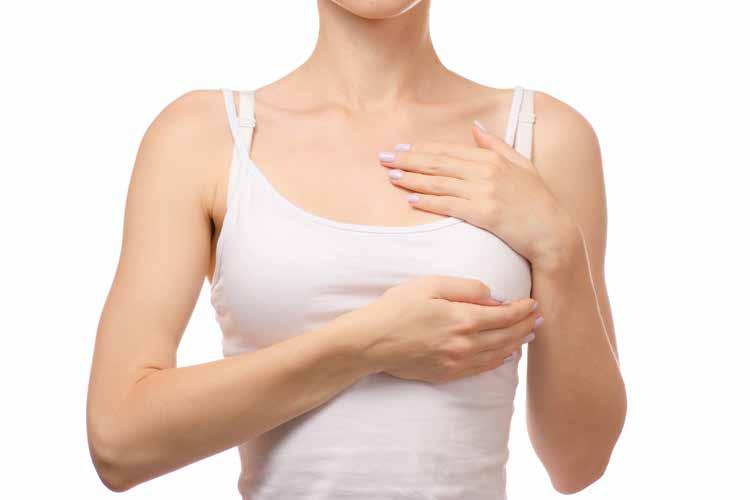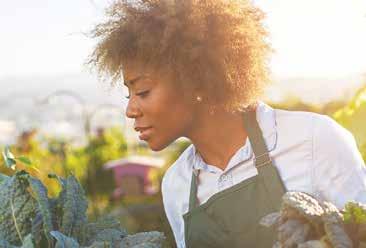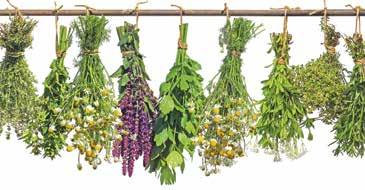
4 minute read
HEALTHY BREAST BASICS
Lifestyle Choices to Lower Disease Risks
by Sandra Yeyati
One in eight women in the United States develops breast cancer in the course of her lifetime. “Notably, only five to 10 percent can be blamed on inherited gene mutations, and merely 13 percent of women with breast cancer have a first-degree relative with a history of disease,” says Kristi Funk, a board-certified breast surgeon in Santa Monica, California, and medical director of PinkLotus.com. “It’s empowering to realize that the causes for the vast majority of breast cancer are under our control in the choices we make every day.” “Whenever you lift fork to mouth, you move closer to cancer, or farther away,” says the author of Breasts: The Owner’s Manual—a vegan proponent. “Plants, legumes and whole grains provide nutritional armor for your cells, decreasing cancer risk. They release molecules that scavenge free radicals, eliminate carcinogens, prevent and repair DNA damage, identify and destroy harmful cells, inhibit the supply of blood to tumors, stimulate the immune system, regulate hormone metabolism and reduce inflammation.” Funk recommends regular consumption of cruciferous vegetables, leafy greens, soy, ground flaxseed, berries, matcha green tea, mushrooms, turmeric, aloe vera, garlic, onion, chives and cacao.
Functional doctor Elizabeth Boham, the medical director of Dr. Mark Hyman’s UltraWellness Center in Lenox, Massachusetts, proposes a balance of animal and vegetable protein, as long as the animal sources are good, like eggs, salmon or grass-fed beef without antibiotics. “Organic, non-GMO soy like tofu or edamame may decrease a woman’s risk of breast cancer, but avoid bad soy that’s added to processed food, including soybean oils and soy lecithins,” she advises. “I also suggest cutting back on dairy for women
at high risk of breast cancer because it naturally contains growth hormones, which may cause things to grow in our body that we don’t want to grow.”
Citing a clear association between alcohol consumption and breast cancer risk, Boham recommends eliminating or moderating drinks to no more than five a week. She also highlights the importance of seven to nine hours of sleep and relaxation techniques to improve stress response.
Maintaining a healthy weight is also important. “Our body fat is where hormones get turned into estrogen, which has been associated with an increase in breast cancer,” Boham says, adding that 35 grams of fiber per day will feed healthy bacteria in the gut which helps eliminate used-up estrogen and other toxins. “Avoid xenoestrogens, too, which can act on the estrogen receptor, such as BPA in plastics and store receipts, parabens in skincare products and pesticides and herbicides on lawns and in non-organic foods.”
Boham suggests eliminating refined and processed carbohydrates like bread, white rice and cookies, which cause blood sugar to spike and the body to produce insulin, the hormone that lowers blood sugar after every meal. “Over time, people develop insulin resistance, causing it to produce even more insulin to do its job. Those high levels of insulin can encourage cancer growth,” she explains.
Carlos Garcia, M.D., director of the Utopia Cancer Center (UtopiaCancerCenter.com), in Oldsmar, Florida, and author of Cancer is a Symptom, uses liver and gallbladder flushes, colonic irrigations and coffee enemas to help the body purge toxins. “Gut flora imbalances compromise the immune response and nutritional absorption. Yearly colonic irrigation with recolonization is essential in the prevention of disease,” he explains.
Some women experience breast tenderness or pain and lumpy, bumpy breast tissue; having dense breasts can increase breast cancer risk, Boham says, noting that too much caffeine or an iodine deficiency can exacerbate these symptoms. She recommends consuming less coffee and more iodine-rich foods like nori, kelp powder or seafood.
According to Boham, there isn’t enough good research to say that we should never wear underwire bras, but good lymphatic flow and circulation to the area is important and can be facilitated with daily movement, exercise and sweating to remove stuck toxins and support the detoxification system.
Boham says many women find their breast cancer during a self-exam. “Know your own body. If something looks or feels different, if you feel a lump that shouldn’t be there or see a shift in the skin, a dimpling or a pulling, have it checked. It’s often nothing, but you could find the cancer early, which makes all the difference in the world.”
Sandra Yeyati, J.D., is a professional writer and editor. Reach her at SandraYeyati@gmail.com.

Discover the Healer in You!
Better Your life and the Lives of Your Family and Friends through the Power of Herbs.

Take Your Passion to the Next Level.
Sign up for our essential class on medicinal herbs and their healing properties. Learn how to select them and make remedies based on body systems.
~ Herbs that Heal ~
There is nothing like nature’s medicine and the healing power of herbs. Become a Certified Herbalist. Learn the role of herbs as foods and medicines throughout history. In this class, you will gain a deeper understanding of the body systems and conditions that herbs affect, the most effective way to use them whether that be by teas, extracts, poultices, ointments or powdered capsules. This class is an excellent place to start for people new to herbal studies and usage or for those who want to expand their working knowledge of herbs. Wholistic Training Institute is a State of Michigan Licensed Proprietary School.

Wholistic Training Institute
Call Today! (313) 255-6155 WholisticTrainingInstitute.com




